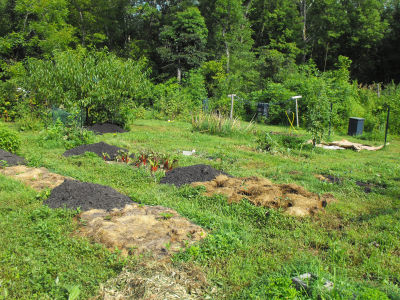
Renovating the back garden
 Our
back garden is a trouble spot. As I've mentioned before, previous
owners had a pasture there and I suspect allowed all of the topsoil to
erode away. What's left is dense clay over a high water table ---
a recipe for crop failure.
Our
back garden is a trouble spot. As I've mentioned before, previous
owners had a pasture there and I suspect allowed all of the topsoil to
erode away. What's left is dense clay over a high water table ---
a recipe for crop failure.
And then there are the
problems that are my own fault. When I built the back garden's raised
beds,
I believed it was best to merely scoop up the topsoil from the aisles
to create the beds. But there was so little topsoil present that
the beds turned out to be barely higher than the surrounding
aisles. A couple of years later, the beds have collapsed a bit
more,
which means that the grass and clover in the pathways encroach
constantly on the "beds", and grass seeds also drift up into the
growing area
as a matter of course. Yet more problems.
Again my fault --- I was
new to pathway planning when I laid out the
back garden, so for some reason I can no longer fathom, I created a
checkerboard of tiny beds. Mowing takes twice as long since you
have to go across the garden horizontally, then again vertically.
Yuck! Can you tell this is my least favorite gardening spot?
I took advantage of Mark's
load of topsoil (aka "compost")
to start fixing all of the back garden's problems. First step ---
merge all of the beds on a contour line into a single long bed by
dumping topsoil in the dividing aisles. Suddenly, I wanted two
more truckloads of soil so that I could also build up the empty beds
(which had been planted in buckwheat and are waiting to be planted in
oats next week.) My goal is to create a replica of my current
favorite garden --- the mule garden --- with long raised beds at least
six inches high. Then I could start to consider the high
groundwater a boon --- subirrigation!
Want more in-depth information? Browse through our books.
Or explore more posts by date or by subject.
About us: Anna Hess and Mark Hamilton spent over a decade living self-sufficiently in the mountains of Virginia before moving north to start over from scratch in the foothills of Ohio. They've experimented with permaculture, no-till gardening, trailersteading, home-based microbusinesses and much more, writing about their adventures in both blogs and books.
Want to be notified when new comments are posted on this page? Click on the RSS button after you add a comment to subscribe to the comment feed, or simply check the box beside "email replies to me" while writing your comment.
